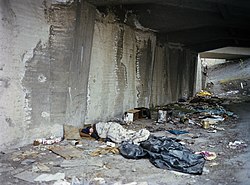
Homelessness in Finland affected 4,396 people at the end of 2021. [1] [2] [a] Long-term homelessness affected 1,318 people. [1]
Contents
Finland and Denmark are the only European Union countries where the long term homelessness trend has been falling. [3] Homelessness in Finland had fallen for eleven years in a row before increasing in February 2025 (figures are from previous November, but reported annually in February) due to the rising cost of living and various cuts to social security, housing and income support. [4]
Finland has adopted a Housing First policy, whereby social services assign homeless individuals homes first, and issues like mental health and substance abuse are treated second. [5] [6] Since its launch in 2008, the number of homeless people in Finland has decreased by roughly 30%, [2] though other reports indicate it could be up to 50%. [7] The number of long-term homeless people has fallen by more than 35%. [3] "Sleeping rough", the practice of sleeping outside, has been largely eradicated in Helsinki, where only one 50-bed night shelter remains. [3] Analysis of Housing First in Tampere, Finland found that it saved €250,000 in one year. [8] A further study of Finland's Housing First program found that giving a homeless person a home and support resulted in cost savings for the society of at least €15,000 per person per year, with potentially even higher cost savings in the long term. [7] These cost savings for society are in part a result of reductions in usage of emergency healthcare, police, and the justice system when homeless people are given a home. [9]
The Constitution of Finland mandates that public authorities "promote the right of everyone to housing". [10] In addition, the constitution grants Finnish citizens "the right to receive indispensable subsistence and care", if needed. [10]
Since 2002, the Night of the Homeless event has been hosted throughout the country. [11] The events include demonstrations, food distribution, and movie screenings, among other activities. [12]